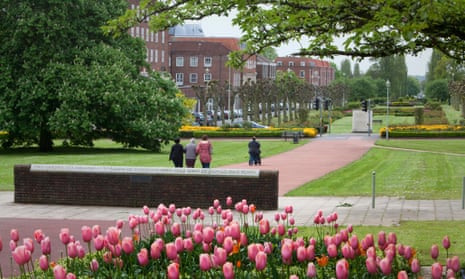“A void south of Swanscombe.” That was this paper’s verdict on Ebbsfleet eight years ago. Things have picked up a little for the Thames estuary town since then. Springhead Park, described as a “modern reinvention of the traditional Kentish village”, has now gone up. A new high-speed rail line will also get you to central London in a fiendishly fast 19 minutes.
Even so, would you choose to live there? Beyond the neat cloisters of new builds, much is still brownfield scrub. As for entertainment, a trip to Bluewater shopping mall remains the week’s highlight. That could all change. Last year, the UK government unveiled plans to convert the town into a flagship garden city.
Garden cities – or ‘eco cities’ or ‘green cities’ as they are sometimes branded – are all the rage in environmental circles. Replacing concrete high-rises and log-jammed roads with energy-efficient buildings, green spaces and car-free zones promises cleaner air and lower greenhouse gas emissions.
Better for our health
What’s good for the planet is good for us too, urban planners insist. According to research by global engineering firm Arup, green cities are healthier, more prosperous and safer. With more than two in three of the world’s population projected to be living in cities by 2050, such claims merit attention. So do they stack up?
The clearest evidence centres on health. As humans, we’re hardwired to enjoy nature, says Tom Armour, director of landscape and urbanism at Arup: “We’ve only really had mass urbanisation for the last 200 years, say, out of our hunter-gather experience of 100,000 years.”
The science backs him up. A 17-year study by Exeter University found that UK householders living in greener urban environments are likely to have lower levels of mental distress and higher levels of wellbeing. The findings back up a classic study on surgical patients that revealed faster recovery time for surgery patients who had a view of trees from their hospital bed (pdf).
Exercise is a big factor too. According to a report commissioned by the Forestry Commission (pdf), people with access to large, attractive open spaces are 50% more likely to achieve high levels of walking. Take Copenhagen; the recent introduction of a network of bicycle superhighways in the Danish capital has reduced sick days and residents’ medical costs by an estimated $12m as a result of improvements in public health.
According to Sue Holden, chief executive of The Woodland Trust, the health benefits of giving everyone in the UK access to green spaces could shave £2.1bn off the NHS healthcare bill every year.
It’s not unreasonable to suppose that a healthier populace results in a more productive, and therefore more prosperous, populace too. Office plants are shown to boost productivity by 15%. How much more would a park on your doorstep achieve? The academics have even come up with a name for the phenomenon: attention restoration theory.
Done well, garden cities can provide the opportunity to attract inward investment and create employment as well. That’s the experience of new towns such as Stevenage and Milton Keynes, argues Kate Henderson, chief executive of the Town and Country Planning Association. Milton Keynes attracts over 16,000 net in-commuters, a Department of Transport study reveals (pdf).
“If you get it right, new garden cities can provide huge economic opportunities [by] planning in adaptable spaces for businesses to come in and want to settle and grow,” she says.
Evidence around public safety is a little more tangential. Mental stress and violence are closely connected, so anything to reduce stress – such as a walk in the park or cycle ride after work – should make us less likely to descend into road rage and the like. Scientists tested the hypothesis in an inner city neighbourhood in Chicago and discovered significantly lower violence scores among residents living in a greener environment (pdf).
Another factor in making streets safer in green cities is the social cohesion that derives from getting out and about more. “People enjoy meeting in parks and getting to know each other,” says Kathleen Rogers, president of the non-profit Earth Day Network.
Inequality
Not all residents experience the benefits of green living equally, however. Very often, it’s the richer neighbourhoods that are earmarked for green developments, Rogers says. While poorer neighbourhoods do have green space, it’s often poorly maintained and under-utilised.
She gives the example of Washington DC, where the more affluent north-west neighbourhoods boast a host of lovely parks. In the poorer north-east, it’s a different story: “They [the parks] aren’t not well-lit. They’re not cared for. They’re the place where the homeless go or where drug deals are made.”
Gentrification further widens such divisions. The ‘greening’ of poor neighbourhoods typically drives property prices up and forces low-income residents out. Such a “mass exodus” is almost “never the intention”, Roger concedes, yet without some form of housing protection guarantee, it’s almost inevitable.
Community ownership, in contrast, stood at the heart of the initial garden city movement when it was conceived more than a century ago. Increases in land value should be reinvested in social infrastructure, not pocketed by private developers, the idea’s pioneers argued. The UK garden city of Letchworth remains true to that vision today.
Ebbsfleet’s redevelopment will be overseen and owned by a private consortium. Filling the void with green space and eco-buildings will be the easy part. Creating a socially inclusive community: that’s where the true test of sustainable living lies.
The human cities hub is funded by Akzo Nobel. All content is editorially independent except for pieces labelled “brought to you by”. Find out more here.
Join the community of sustainability professionals and experts. Become a GSB member to get more stories like this direct to your inbox.

Comments (…)
Sign in or create your Guardian account to join the discussion